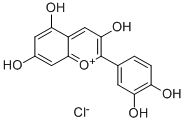All AbMole products are for research use only, cannot be used for human consumption.

Cyanidin chloride is a subclass of anthocyanin, displays antioxidant and anti-carcinogenesis properties, could be used for treatment of diabetes mellitus complications. Cyanidin Chloride (IdB 1027) inhibits receptor activator of NF-κB ligand (RANKL)-induced NF-κB activation, suppresses the degradation of IκB-α and attenuates the phosphorylation of extracellular signal-regulated kinases (ERK). Cyanidin Chloride (IdB 1027) abrogates RANKL-induced calcium oscillations, the activation of nuclear factor of activated T cells calcineurin-dependent 1 (NFATc1), and the expression of c-Fos. Cyanidin Chloride (IdB 1027) protects against OVX-induced bone loss in OVX-induced osteoporosis mouse model.
| Molecular Weight | 322.7 |
| Formula | C15H11ClO6 |
| CAS Number | 528-58-5 |
| Form | Solid |
| Solubility (25°C) | DMSO 20 mg/mL |
| Storage | -20°C, sealed |
| Related Products |
|---|
| L-Lactic acid lithium
L-Lactic acid lithium is a lithium salt of L-Lactic acid with certain bioconductive properties. L-Lactic acid can be used as a precursor for the production of bioplastic polymer polylactic acid. |
| Lithium lactate
Lithium lactate (Lithium 2-hydroxypropanoate) is a kind of biological materials or organic compounds that are widely used in life science research. Lithium lactate is a biochemical reagent which can be used for the determination of lactic acid. |
| Lithium stearate
Lithium stearate (Stearic acid lithium) is a compound that forms vesicles in reaction with silver nitrate, thereby changing the reaction kinetics of the nucleation and self-assembly process of silver stearate. |
| cyclo(Ala-Ile)
cyclo(Ala-Ile) is a biochemical material that can be used in scientific research. |
| Myoglobin (from equine skeletal muscle)
Myoglobin is a small molecular pigment protein formed by binding globin to Heme, which can be reversibly bound to oxygen to form MbO2, MbO2 is called oxymyoglobin, and Mb is called deoxymyoglobin. Myoglobin has the role of transporting and storing oxygen in muscle cells. |
All AbMole products are for research use only, cannot be used for human consumption or veterinary use. We do not provide products or services to individuals. Please comply with the intended use and do not use AbMole products for any other purpose.


Products are for research use only. Not for human use. We do not sell to patients.
© Copyright 2010-2024 AbMole BioScience. All Rights Reserved.
